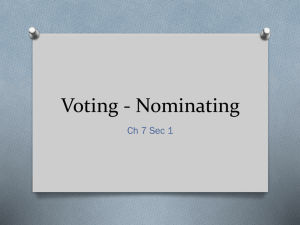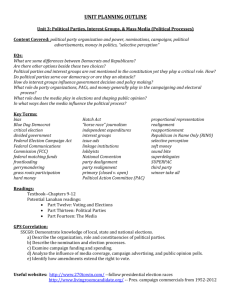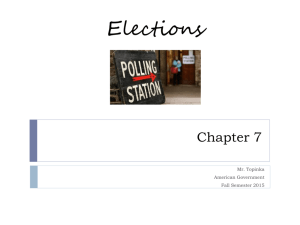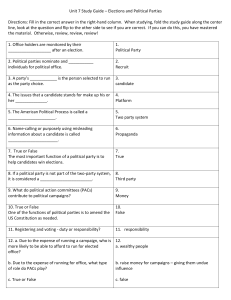The Electoral Process - Scott County Public Schools
advertisement
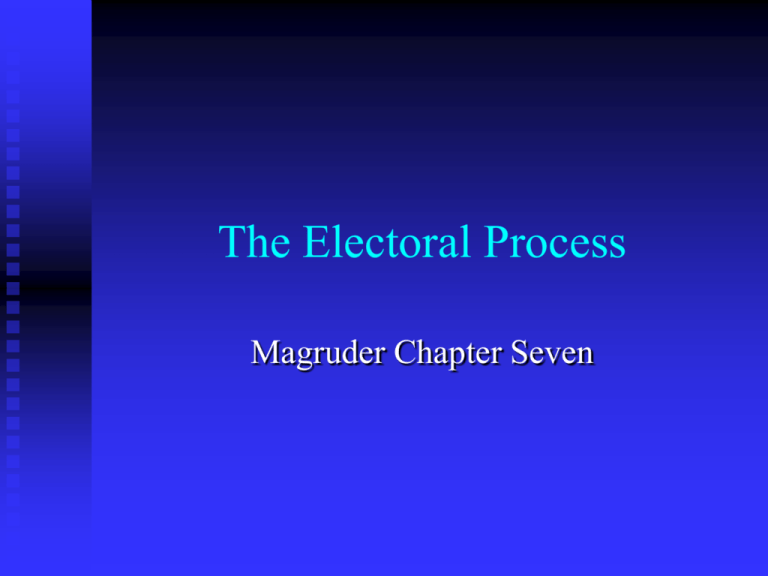
The Electoral Process Magruder Chapter Seven The Nominating Process The Importance of Nominations The nominating process is important because the United States has a strong twoparty system, which means that there are usually only two viable candidates for any office There are five major ways in which nominations can be made Self-Announcement Self-announcement is the oldest form of the nominating process It is often used by people running in small towns or rural areas It is also used by people at higher levels who fail to get their party’s nomination or are unhappy with its choice The Caucus A caucus is a group of like-minded people that meets to select the candidates it will support in an upcoming election Early caucuses were private meetings made up of a few influential figures Caucuses are still used to make local nominations in some areas, but they are now open to all members of a party The Convention Nominating conventions were first used in the 1830s and quickly caught on as the only way to select presidential candidates In each local area, party members elect delegates to represent them at county conventions; county conventions elect delegates to State conventions; The Convention State conventions elect delegates to the national convention who select the party’s presidential and vice-presidential nominees The process was corrupted by party bosses and fell out of favor in the late 1800s The Direct Primary The direct primary is an election held within a party to pick the party’s candidates for the general election The Closed Primary – in a closed primary only declared party members can vote to decide which candidate the party will support The Direct Primary The Open Primary – in an open primary any qualified voter may vote to decide which candidate a party will support The Closed vs. the Open Primary – Americans make strong arguments for and against both types of primary The Direct Primary The Runoff Primary – in States that demand that the winning candidate of each party holds an absolute majority of that party’s votes, runoff primaries are held in which voters must choose between the two top vote-getters The Direct Primary The Nonpartisan Primary – most school and municipal officials and, often, State judges, are chosen from ballots that do not identify candidates by party affiliation Evaluation of the Primary – Primaries are costly and divisive and many voters neither recognize their importance nor inform themselves sufficiently to make wise choices The Direct Primary The Presidential Primary – in these elections, voters declare their preference for a particular candidate and/or elect delegates to a party’s national convention Nomination by Petition At the local level, this process is commonly used for nonpartisan posts In some States, election laws require that minor-party or independent candidates get a certain number of signatures before they are put on the ballot Elections The Administration of Elections The Extent of Federal Control Most election law is State law Congress sets the time, place, and manner of congressional elections It has also passed laws designed to protect the right to vote and prevent election fraud The Administration of Elections When Elections are Held Most States hold elections for State offices in November of every even-numbered year Some States hold certain elections at other times, usually in the spring The Administration of Elections The Coattail Effect A popular candidates at the top of the ticket helps other candidates form the same party Some argue that State and local elections should be held at different times than presidential elections in order to lessen this “coattail effect” Precincts and Polling Places State law restricts the population size of voting districts, or precincts Precinct election boards ensure that elections are held in an orderly manner, and each political party sends poll watchers to watch for election fraud The Ballot The Australian Ballot – this secret ballot, printed at public expense and given out only at polling places, was a reform introduced in the late 1800s The Office-Group Ballot – this form of the Australian ballot groups candidates for each office together The Ballot The Party-Column Ballot – this form of the Australian ballot lists each party’s candidates in a column under the party’s name Sample Ballots – clearly marked sample ballots are mailed to voters in many States and appear in newspapers to help the voters prepare for an election The Ballot The Long and Short of It – traditionally, Americans prefer to elect, rather than appoint, large numbers of local officials on the theory that the greater the number of elected officials, the more democratic the government Voting Machines and Innovations Invented by Thomas Edison, voting machines were first used in 1892 Electronic Vote Counting – Electronic data processing techniques are now in use in many States Vote-by-Mail elections – mail-in ballots are allowed in some local elections, and on at least one occasion, in elections for national office as well Money and the Election Process Campaign Spending Amounts Observers estimate that about $750 million was spent on the 1996 presidential election Money is used for many purposes – staff and office costs, polling, television time, and so forth Sources of Campaign Funding Private Givers – the candidates themselves, individual citizens, PACs, and temporary campaign organizations all contribute money to political campaigns Why People Give – Some give to support candidates and policies they believe in; others want access to government in return for their financial support Regulating Campaign Finance The Federal Election Commission (FEC) – the FEC is an independent agency whose members set limits on campaign contributions and spending, require prompt disclosure of campaign finance data, and administer public funds for part of the presidential election process Regulating Campaign Finance Disclosure Requirements – Strict laws govern who can contribute to political campaigns, how much each person can give, and how campaign funds may be spent The Role of PACs – PACs, which have grown rapidly in recent years, may contribute up to $5,000 to any presidential candidate Regulating Campaign Finance Limits on Contributions – Federal law limits contributions by individuals, unions, national banks, and corporations Limits on Expenditures – Federal law limits spending in presidential campaigns Public Funding of Presidential Campaigns – Monies for public funding of campaigns are contributed by individual citizens at income-tax time Regulating Campaign Finance Preconvention Period – The FEC provides public funds to candidates by matching private, individual contributions National Conventions – Each party automatically receives a grant of public funds to pay for its national convention Presidential Campaigns – Major-Party nominees automatically qualify for a public subsidy to cover campaign costs

